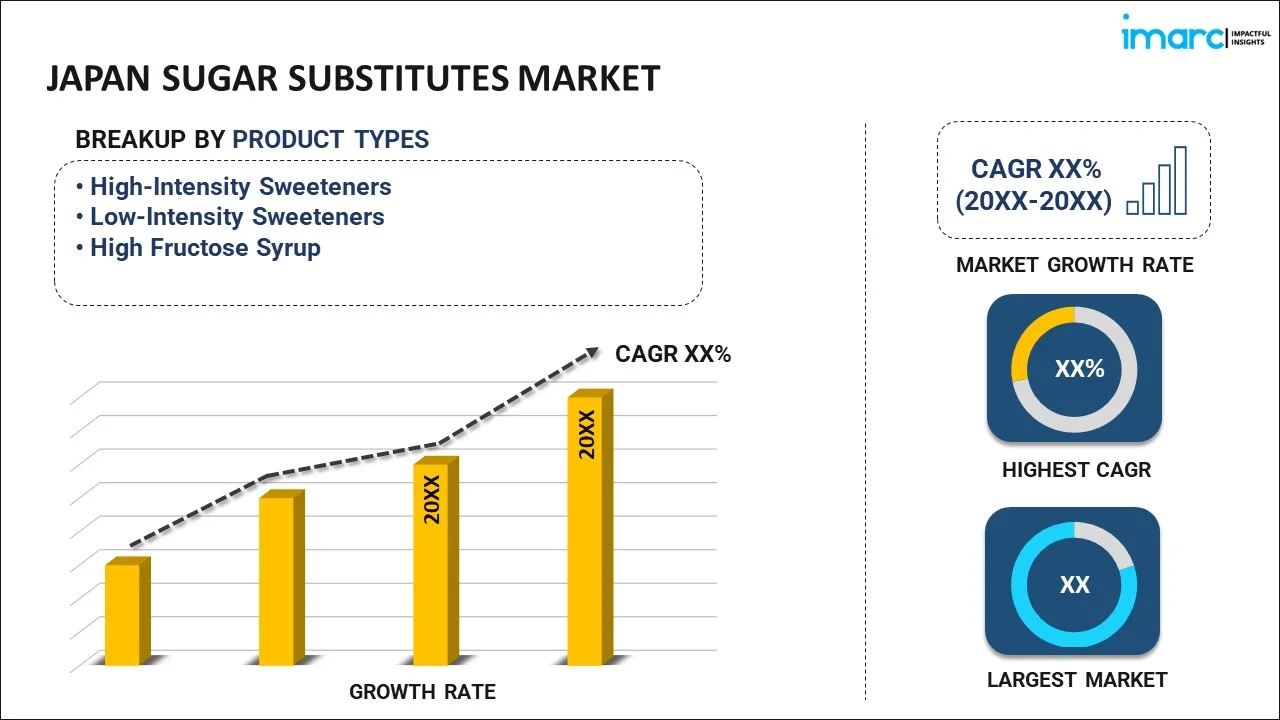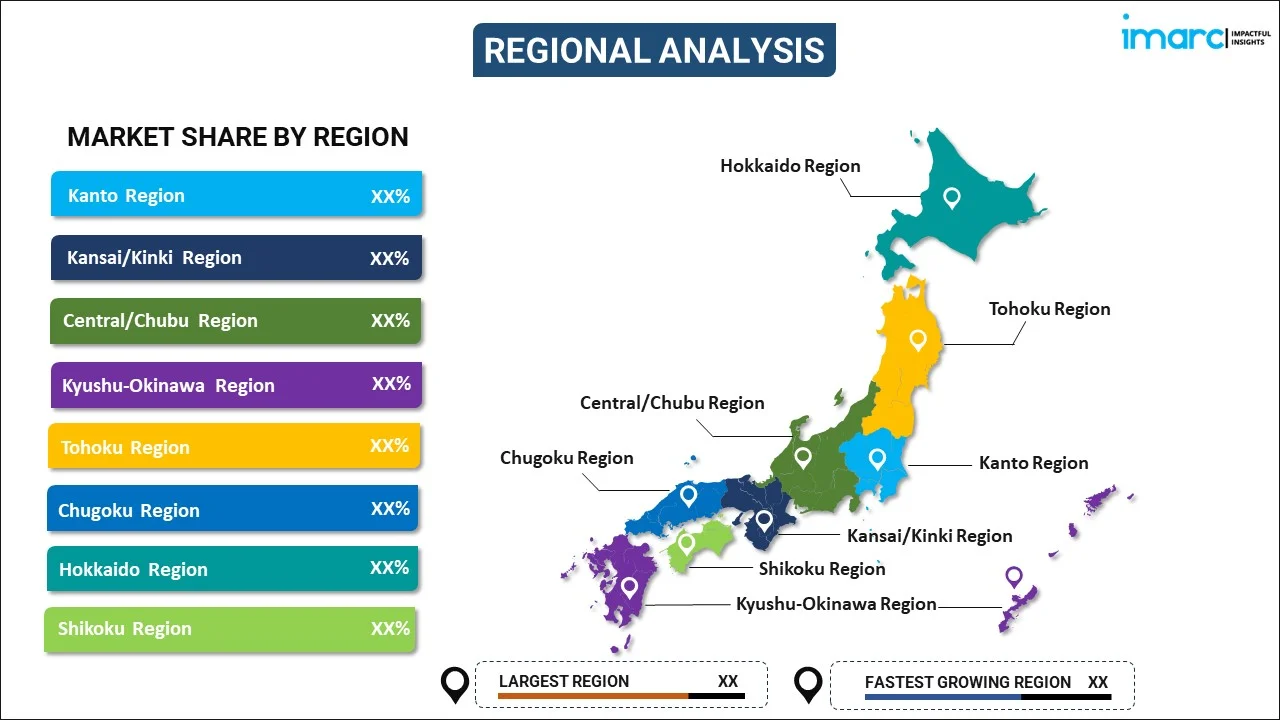
Japan Sugar Substitutes Market Report by Product Type (High-Intensity Sweeteners, Low-Intensity Sweeteners, High Fructose Syrup), Application (Foods, Beverages, Health and Personal Care), Origin (Artificial, Natural), and Region 2025-2033
Market Overview:
Japan sugar substitutes market size reached USD 680.4 Million in 2024. Looking forward, IMARC Group expects the market to reach USD 1,037.6 Million by 2033, exhibiting a growth rate (CAGR) of 4.4% during 2025-2033. The market is being driven by several significant factors, including the growing preferences of health-conscious consumers, the escalating rates of diabetes and obesity, and the various innovations introduced by the food and beverage industry in the development of sugar-free and low-sugar products.
|
Report Attribute
|
Key Statistics
|
|---|---|
|
Base Year
|
2024
|
|
Forecast Years
|
2025-2033
|
|
Historical Years
|
2019-2024
|
|
Market Size in 2024
|
USD 680.4 Million |
|
Market Forecast in 2033
|
USD 1,037.6 Million |
| Market Growth Rate 2025-2033 | 4.4% |
Sugar substitutes, also known as artificial sweeteners or sugar alternatives, are substances utilized in the food and beverage industry to replicate the sweet taste of sugar while imparting fewer or zero calories. They are a popular choice among individuals seeking to reduce their sugar intake for various reasons, such as managing their weight or controlling blood sugar levels. Sugar substitutes can originate from natural sources like plants (e.g., stevia extract) or be artificially synthesized in laboratories (e.g., aspartame or saccharin). They possess a significantly higher sweetness intensity compared to sugar, necessitating only minimal quantities to achieve the desired level of sweetness. An advantageous feature of sugar substitutes is their ability to sweeten food and beverages without causing a rapid spike in blood glucose levels, rendering them suitable for diabetics and those regulating their sugar consumption.
Japan Sugar Substitutes Market Trends:
The sugar substitutes market in Japan is experiencing notable growth driven by several key factors. Firstly, Japan's heightened focus on health and wellness has prompted a significant shift in consumer preferences towards sugar-free and low-calorie alternatives. This change is particularly driven by individuals aiming to manage their weight and maintain healthier lifestyles, contributing to the increased demand for sugar substitutes in the country. Secondly, Japan has a substantial population dealing with health conditions like diabetes and obesity. As a result, there is a growing awareness among individuals about the importance of reducing sugar consumption to manage these health issues. Furthermore, the food and beverage industry in Japan has been actively engaged in innovations to create sugar-free and low-sugar products that cater to the evolving consumer preferences. These innovations include the utilization of a variety of sugar substitutes, both natural and synthetic, to enhance the taste and appeal of products while reducing sugar content. Overall, the Japan sugar substitutes market is on an upward trajectory, fueled by health-conscious consumer choices, a growing diabetic population, and industry innovations aimed at providing healthier food and beverage options.
Japan Sugar Substitutes Market Segmentation:
IMARC Group provides an analysis of the key trends in each segment of the market, along with forecasts at the country level for 2025-2033. Our report has categorized the market based on product type, application, and origin.
Product Type Insights:

- High-Intensity Sweeteners
- Stevia
- Aspartame
- Cyclamate
- Sucralose
- Saccharin
- Others
- Low-Intensity Sweeteners
- D-Tagatose
- Sorbitol
- Maltitol
- Xylitol
- Mannitol
- Others
- High Fructose Syrup
The report has provided a detailed breakup and analysis of the market based on the product type. This includes high-intensity sweeteners (stevia, aspartame, cyclamate, sucralose, saccharin, and others), low-intensity sweeteners (D-tagatose, sorbitol, maltitol, xylitol, mannitol, and others), and high fructose syrup.
Application Insights:
- Foods
- Beverages
- Health and Personal Care
A detailed breakup and analysis of the market based on the application have also been provided in the report. This includes foods, beverages, and health and personal care.
Origin Insights:
- Artificial
- Natural
The report has provided a detailed breakup and analysis of the market based on the origin. This includes artificial and natural.
Regional Insights:

- Kanto Region
- Kansai/Kinki Region
- Central/ Chubu Region
- Kyushu-Okinawa Region
- Tohoku Region
- Chugoku Region
- Hokkaido Region
- Shikoku Region
The report has also provided a comprehensive analysis of all the major regional markets, which include Kanto Region, Kansai/Kinki Region, Central/ Chubu Region, Kyushu-Okinawa Region, Tohoku Region, Chugoku Region, Hokkaido Region, and Shikoku Region.
Competitive Landscape:
The market research report has also provided a comprehensive analysis of the competitive landscape. Competitive analysis such as market structure, key player positioning, top winning strategies, competitive dashboard, and company evaluation quadrant has been covered in the report. Also, detailed profiles of all major companies have been provided.
Japan Sugar Substitutes Market Report Coverage:
| Report Features | Details |
|---|---|
| Base Year of the Analysis | 2024 |
| Historical Period | 2019-2024 |
| Forecast Period | 2025-2033 |
| Units | Million USD |
| Scope of the Report | Exploration of Historical Trends and Market Outlook, Industry Catalysts and Challenges, Segment-Wise Historical and Future Market Assessment:
|
| Product Types Covered |
|
| Applications Covered | Foods, Beverages, Health and Personal Care |
| Origins Covered | Artificial, Natural |
| Regions Covered | Kanto Region, Kansai/Kinki Region, Central/ Chubu Region, Kyushu-Okinawa Region, Tohoku Region, Chugoku Region, Hokkaido Region, Shikoku Region |
| Customization Scope | 10% Free Customization |
| Post-Sale Analyst Support | 10-12 Weeks |
| Delivery Format | PDF and Excel through Email (We can also provide the editable version of the report in PPT/Word format on special request) |
Key Questions Answered in This Report:
- How has the Japan sugar substitutes market performed so far and how will it perform in the coming years?
- What has been the impact of COVID-19 on the Japan sugar substitutes market?
- What is the breakup of the Japan sugar substitutes market on the basis of product type?
- What is the breakup of the Japan sugar substitutes market on the basis of application?
- What is the breakup of the Japan sugar substitutes market on the basis of origin?
- What are the various stages in the value chain of the Japan sugar substitutes market?
- What are the key driving factors and challenges in the Japan sugar substitutes?
- What is the structure of the Japan sugar substitutes market and who are the key players?
- What is the degree of competition in the Japan sugar substitutes market?
Key Benefits for Stakeholders:
- IMARC’s industry report offers a comprehensive quantitative analysis of various market segments, historical and current market trends, market forecasts, and dynamics of the Japan sugar substitutes market from 2019-2033.
- The research report provides the latest information on the market drivers, challenges, and opportunities in the Japan sugar substitutes market.
- Porter's five forces analysis assist stakeholders in assessing the impact of new entrants, competitive rivalry, supplier power, buyer power, and the threat of substitution. It helps stakeholders to analyze the level of competition within the Japan sugar substitutes industry and its attractiveness.
- Competitive landscape allows stakeholders to understand their competitive environment and provides an insight into the current positions of key players in the market.
Need more help?
- Speak to our experienced analysts for insights on the current market scenarios.
- Include additional segments and countries to customize the report as per your requirement.
- Gain an unparalleled competitive advantage in your domain by understanding how to utilize the report and positively impacting your operations and revenue.
- For further assistance, please connect with our analysts.
 Inquire Before Buying
Inquire Before Buying
 Speak to an Analyst
Speak to an Analyst
 Request Brochure
Request Brochure
 Request Customization
Request Customization




.webp)




.webp)












